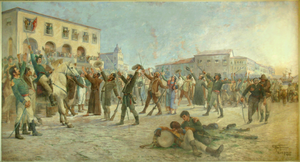| Independence of Brazil in Bahia | |||||||
|---|---|---|---|---|---|---|---|
| Part of the War of Independence of Brazil | |||||||
 O Primeiro Passo para a Independência da Bahia, or, The First Step towards the Independence of Bahia, by Antônio Parreiras | |||||||
| |||||||
| Belligerents | |||||||
|
|
| ||||||
| Commanders and leaders | |||||||
|
|
| ||||||
| Strength | |||||||
|
14 000 Rebels 1 Ship of the line 3 Frigates 2 Corvettes 5 other Warships |
10 500 Soldiers 1 Ship of the line 2 Frigates 8 Corvettes 3 other Warships | ||||||
The Independence of Brazil in Bahia, [1] Also called Bahia's Independence,[2][3][4][5] Was a movement which began on February 19 1822 and concluded on July 12 1823, motivated by a rise in Brazilian nationalism and Federalism and ended with Bahia becoming a province província na unidade nacional brasileira, consolidando a Independência do Brasil.[6][7]
Salvador joined the 1820 Liberal Revolution of Porto, and, with the convening of the The General and Extraordinary Cortes of the Portuguese Nation, in January of the following year, Salvador sent deputies such as Miguel Calmon du Pin e Almeida to defend local interests. The city found itself divided into several factions, the liberals uniting Portuguese and Brazilians, interested in maintaining the conditions achieved with the Transfer of the Portuguese court to Brazil, and Portuguese people interested in returning to the kingdom's previous state.[8] With divided interests, tempers intensified: on one hand, Portuguese interested in keeping the province as a colony, and on the other, Brazilians, liberals, conservatives, monarchists and even republicans, finally unite in the common interest of a fight that has been going on for almost a year, and that can only be done unified with the Independence of Brazil itself from June 14 of 1822, when the proclamation was made in the Town Hall of Santo Amaro da Purificação that preached national unity, and recognized the authority of D. Pedro I.[9].[9]
- ^ "Lei n.º 12.819, de 5 de junho de 2013". Presidência da República Federativa do Brasil. 5 June 2013. Retrieved 12 September 2014.
- ^ "O 2 de julho – Independência do Brasil na Bahia". Salvador da Bahia (in Brazilian Portuguese). 2019-07-01. Retrieved 2021-05-27.
- ^ "Dois de Julho — A Independência do Brasil na Bahia - TV Câmara". Portal da Câmara dos Deputados (in Brazilian Portuguese). Retrieved 2021-05-27.
- ^ Setembro, Governo da Bahia Governo do Estado da Bahia Fundação Pedro Calmon Av Sete de; N° 282; Brasilgás, Edifício; Ao 8º, 5º; Brasil, ares-Centro CEP 40 060-000- Salvador- Bahia Localização Exerça sua cidadania Fale com a Ouvidoria Todo o conteúdo desse site está publicado sob a licença Creative Commons Atribuição-SemDerivações 3 0. "Independência do Brasil na Bahia 2017 | História - Fundação Pedro Calmon - Governo da Bahia". www.fpc.ba.gov.br (in Brazilian Portuguese). Retrieved 2021-05-27.
{{cite web}}: CS1 maint: numeric names: authors list (link) - ^ "Independência do Brasil na Bahia (Coleção Bahia de Todos) « EDUFBA – Editora da Universidade Federal da Bahia" (in Brazilian Portuguese). Retrieved 2021-05-27.
- ^ "Independência da Bahia: A consolidação do nacionalismo e o surgimento de novos heróis da Pátria - Noticiário do Exército". Notícias (in Brazilian Portuguese). Retrieved 2021-05-31.
- ^ Bahia, Alô Alô. "João Roma quer instituir o 2 de julho como Dia da Consolidação da Independência do Brasil". Alô Alô Bahia (in Brazilian Portuguese). Retrieved 2021-05-31.
- ^ Luís Henrique Dias Tavares in: Aspectos do 2 de Julho. Secretaria Estadual de Educação e Cultura. 1973.
- ^ a b Cite error: The named reference
tavaresartigowas invoked but never defined (see the help page).
